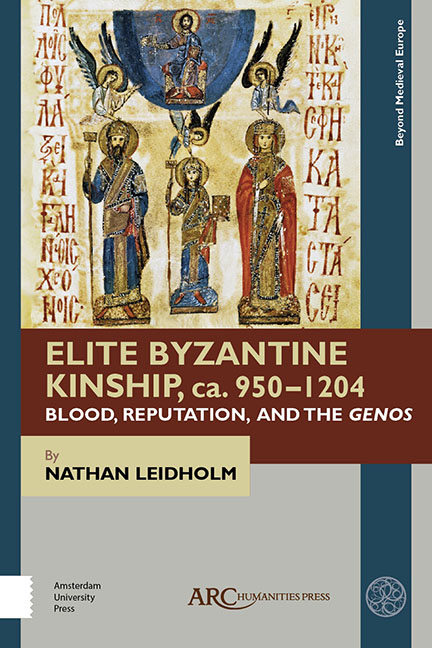Book contents
- Fronrtmatter
- Contents
- List of Abbreviations
- Abbreviation
- Acknowledgements
- Introduction
- Chapter 1 Defining “the Family” in Byzantine Sources and the Modern Historiography
- Chapter 2 The Language of Kinship
- Chapter 3 Marriage Impediments and the Concept of Family
- Chapter 4 Interrogating Consanguinity in a Byzantine Context
- Chapter 5 Family Names and the Politics of Reputation
- Chapter 6 Kinship and Political Developments of the Eleventh and Twelfth Centuries
- Conclusion
- Select Bibliography
- Index
- Fronrtmatter
- Contents
- List of Abbreviations
- Abbreviation
- Acknowledgements
- Introduction
- Chapter 1 Defining “the Family” in Byzantine Sources and the Modern Historiography
- Chapter 2 The Language of Kinship
- Chapter 3 Marriage Impediments and the Concept of Family
- Chapter 4 Interrogating Consanguinity in a Byzantine Context
- Chapter 5 Family Names and the Politics of Reputation
- Chapter 6 Kinship and Political Developments of the Eleventh and Twelfth Centuries
- Conclusion
- Select Bibliography
- Index
Summary
“BASIL VATATZES [D. 1194], the scion of an undistinguished family (γένους μὲν ἀσήμου), had been honoured with the office of Domestic of the East and girded with the ducal command of the Thrakesion theme because he was married to the emperor's second cousin on his father's side.” With these words the Byzantine historian Niketas Choniates describes the beginnings of the meteoric rise of the family of Batatzes (alternately written as Vatatzes). Within a single generation, Basil's descendants could be counted among the most politically and socially influential people in Byzantium and its successor states after 1204. By the first few decades of the thirteenth century, the name of Batatzes appeared alongside those of Komnenos, Doukas, and others, whose impeccable nobility had been established and celebrated since at least the eleventh century. Basil's marriage was, according to Choniates, enough to raise his family (genos) out of obscurity in a single moment. By joining his family to that of the emperor, however distantly, Batatzes immediately associated himself, his relatives, and his descendants with the most powerful elements of Byzantine society and politics.
Basil's story is emblematic of the way in which Byzantine politics had become family politics by the late twelfth century. Over the course of the previous few centuries, imperial authority had merged with the system of social hierarchy and cultural values of the Byzantine aristocracy, which had themselves been transformed in that same time. Within this system, the genos emerged as the cornerstone of aristocratic identity and factional politics.
The Byzantine aristocratic genos (γένος, pl. γένη/ genē) is alternately treated by modern scholars as a western European-style lineage, some kind of nebulous “clan,” or is simply left untranslated. Most have viewed it as a kind of amorphous, poorly defined Byzantine “extended family,” and have contrasted the genos with the oikos/ household or nuclear family. Despite the fact that it was foundational to the social and political structure of the Byzantine aristocracy from at least the eleventh century, the precise nature of the genos as a distinct form of kin group remains relatively unexplored among modern scholarship.
What follows is a study of the genos as both a social group and, importantly, a concept.
- Type
- Chapter
- Information
- Elite Byzantine Kinship, ca. 950–1204Blood, Reputation, and the Genos, pp. 1 - 12Publisher: Amsterdam University PressPrint publication year: 2019

